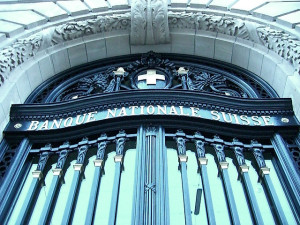By Peter Ward January 29, 2016

Swiss National Bank © marcokalmann
The U.S. – The World’s Biggest Tax Haven?
The U.S. has for years criticized other countries for providing tax havens to rich Americans looking to hide their money offshore. But a feature published this week in Bloomberg Businessweek, reveals that the U.S. is fast becoming the go-to place to hide foreign wealth.
The article claims that wealthy people from around the world are moving accounts from places such as the Bahamas and the British Virgin Islands to Nevada, Wyoming and South Dakota.
Reporter Jesse Drucker cites Peter A. Cotorceanu, a lawyer at Anaford AG, a Zurich law firm, who writes in a recent legal journal, “How ironic—no, how perverse—that the USA, which has been so sanctimonious in its condemnation of Swiss banks, has become the banking secrecy jurisdiction du jour. That ‘giant sucking sound’ you hear? It is the sound of money rushing to the USA.”
Drucker does an excellent job of getting a wide range of people talking, which must have taken some boots-on-the-ground work, considering the highly secretive nature of the business. He managed to track down the offices of one Rothschild trust company in Reno, Nevada, for example, which is moving money from offshore havens to the U.S. He also does a great job of explaining a relatively complex topic without oversimplifying.
India’s Power Mapped

Delhi’s Old Town, India ©elwillybobby
Many in the Western world take electricity for granted, but a recent data visualization depicts the struggle to gain access to power in one of the world’s most populous countries.
An interactive mapping project by the University of Michigan and the World Bank, highlighted by The Atlantic’s Citylab on Wednesday, shows how access to electric power in India has improved over the past 20 years.
Viewers can examine electricity output data for a particular city, state or for the country as a whole on a month by month basis, and scroll forward and back through the years to see how the numbers changed over time.
The creators of the map explained the obvious benefits of electricity for people living in India and other developing countrie in an associated blog post: “People greatly benefit from access to electricity. Kids can study in the evenings, families can have better access to news, farms can use electric tools, and businesses can stay open later. Switching from kerosene to electric lighting results in better air quality and improved health for family members.”
The research shows that over 310 million people in India still live without electricity in their homes, and more than 90% of those people live in rural areas.
Counting the Cost of Jonas

Blizzard Jonas, Washington D.C. ©Geoff Alexander
The East Coast of the U.S. began a massive clean up operation on Monday, after the winter storm Jonas slammed into several states and major cities, including New York, New Jersey and the nation’s capital Washington D.C.
Several economists and news organizations have attempted to calculate the cost of the storm, a task which is much more difficult than it may first appear. The Atlantic ran a story on Monday looking at these various attempts. The price tag on cleaning up the snow alone is astronomical – New York City’s controller estimates $1.8 million per inch. There is also a steep rise in insurance claims during winter storms, and businesses lose money because they are forced to send employees home and close for the day.
A macroeconomist at IHS Global Insight, Chris Christopher, estimated the cost of the storm at between $500 million and $1 billion. That figure was revised upwards from an earlier prediction of up to $850 million.
The economic impact on workers was varied, as some were able to work from home, and salaried employees were able to sit back and relax, knowing they were still earning. But winter storms impact hourly workers the most – one report found that lost wages of hourly workers account for two thirds of the economic impact of a snow storm.
The $15 Minimum Wage Debate Explained
The minimum wage has become a major campaign issue in the 2016 presidential elections.
Raising the minimum wage has widespread support from Democrats and even some Republicans, such as presidential nominee candidate Rick Santorum. Hillary Clinton proposes raising minimum wage to $12, Bernie Sanders wants a minimum wage of $15, and a recent poll of U.S. city mayors by Politico revealed that two thirds supported a wage hike, with one third backing a rise to $15. (Nearly three quarters of the respondents in the Politico survey were Democrats.) The majority of Republican presidential candidates, meanwhile, are against raising minimum wage, though Trump’s position is unclear. At first he said he couldn’t support a $15 minimum wage during a GOP debate in November, but he later seemed to take that back on Twitter.
The biggest argument in favor of a $15 minimum is that it in the current economy, anything less pushes minimum wage workers below the poverty line, and that hard-working Americans should not live in poverty. The main counterargument is that raising the minimum wage to $15 would result in increased unemployment, as companies would end up letting some workers go rather than take the a hit to profits.
What does the research say?
When the minimum wage was increased in 1996 and 1997, the unemployment rate actually fell afterward, according to The Associated Press. After a hike in 2007, unemployment remained unchanged for six months until the Great Recession began. Meanwhile, if you look at data going back to the 70s, four of the five times a minimum wage increase was followed by higher unemployment, there was a recession already underway, according to Politifact.
Timothy B. Lee, a writer for Vox, argues, however, that a large minimum wage increase across the whole of the U.S. could have a negative effect on poorer areas. “A $15-per-hour minimum wage may make sense for the handful of wealthy cities that have adopted it in the past couple of years. But that doesn’t mean it’s a good idea for the rest of the country, where average productivity is a lot lower,” he writes.
Lee notes that supporters of minimum wage increases consistently cite a 1993 study by David Card and Alan Krueger that shows that an increase in minimum wage in New Jersey the previous year did not result in job losses in the fast food industry. But as Lee points out, Kruger himself wrote in an October op-ed in The New York Times that a $15 minimum wage could have undesirable and unintended consequences.
Top Ten: The Week’s Biggest Biz Headlines
The $29 Trillion Corporate Debt Hangover That Could Spark a Recession – Sally Bakewell, Bloomberg
Google agrees to face grilling from MPs on ‘sweetheart’ tax deal – Rowena Mason and Matthew Weaver, The Guardian
Facebook Climbs To 1.59 Billion Users And Crushes Q4 Estimates With $5.8B Revenue – Josh Constine, TechCrunch
Apple shares fall most in two years in wake of earnings report – Supantha Mukherjee, Reuters
Federal Reserve acknowledges slower growth, leaves interest rates unchanged – Ylan Q. Mui, The Washington Post
Oil Trade Slows as Storage Glut Snares Tankers in Bottlenecks – Alaric Nightingale, Bloomberg
Theranos Lab Practices Pose Risk to Patient Health, Regulators Say – John Carreyrou, The Wall Street Journal
Google tax: European Commission ‘willing to probe deal’ – BBC
McDonald’s US sales surge, thanks to all-day breakfast – Akin Oyedele, Business Insider
Can Iran deliver on promises to ramp up oil production? – Alexandra Zavis and Ramin Mostaghim, LA Times
This entry was posted on Friday, January 29th, 2016 at 4:52 pm. It is filed under Week in Review and tagged with $15 minimum wage, India electricity, Jonas, U.S. tax haven. You can follow any responses to this entry through the RSS 2.0 feed.
Comments are closed.
